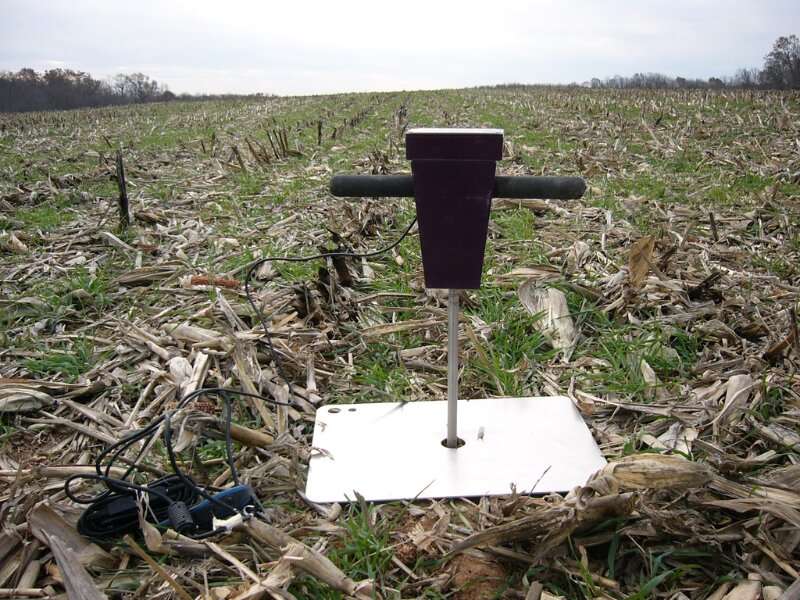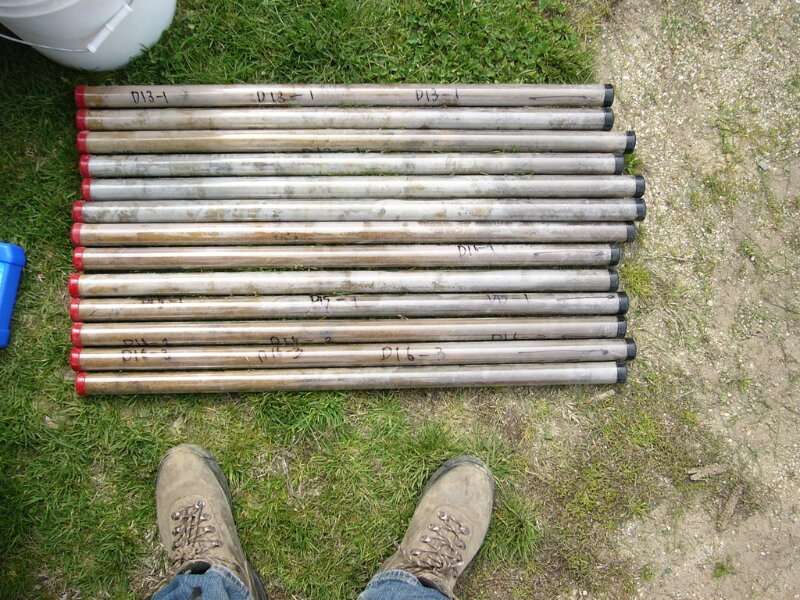A penetrometer placed in a cornfield after harvest to measure soil hardness. Where the portable sensor could not estimate yield, the penetrometer was useful in identifying low-yielding areas. Credit: Rintaro Kinoshita
If you're a gardener, you know that planting seeds in the ground doesn't always mean you'll have a good yield at the end of growing season. On a personal level, this can be disappointing. Farmers are in charge of growing dozens to thousands of acres of food. And, they face the same variability in the planting, growing, and harvesting processes as gardeners do.
Agronomists and soil scientists research best practices for farmers to help them make informed decisions on managing their fields and crops. Rintaro Kinoshita and a team of researchers determined that a tool, an "apparent electrical conductivity sensor (ECa)," can give important insights into farm field management.
Kinoshita is an assistant professor at Obihiro University of Agriculture and Veterinary Medicine, Japan, but performed this research while working at Cornell University, United States.
The study was published in Agronomy Journal.
"In larger farms there are factors that limit yield, or cause variations in yield within a field," says Kinoshita. "Understanding these factors is crucial for optimizing resource investments and financial returns. It also helps avoid adverse environmental effects."
Of course, the soil and its characteristics are some of the most important factors to farming. Spatial variation of crop yield is largely dependent on three factors: topography, soil, and pests/diseases. The soil factor is important and one that farmers can manage.
Soil cores collected from the same farm fields. The research team compared results from soil tests to the finds from various sensing technologies to determine which were the most accurate. Credit: Rintaro Kinoshita
Farmers often rely on soil tests to understand the properties—but these take time and are expensive. Kinoshita and the team used sensor-based technologies that can collect various crop and soil information, without digging up the soils. These sensors are portable with the help of farm equipment like tractors, and provide critical information. In order to calibrate the information, they compared their sensor data with that from soil samples.
Although the research was done while Kinoshita was working at Cornell University, the study was conducted in Maryland and Delaware, in the Coastal Plain and Piedmont. The team studied 26 cornfields in two contrasting geographical and topical areas.
The apparent electrical conductivity sensor (ECa) was the most successful in estimating soil properties compared to the soil samples taken. These sensors were able to predict soil texture—especially at different depths, and available water content. Since water is the only conducting phase, measurements of soil properties that affect water availability can be predicted using ECa. The measurements related to soil moisture and corn yield, which is valuable information for farmers.
The team also tested other technologies, but the findings were not as conclusive as the apparent electrical conductivity sensor. An advantage to collecting sensor measurements is that it is timely, usually taking 1-2 hours per fifty acres. Soil core testing, on the other hand, can take weeks to sometimes months depending on the soil properties.
"I chose to use the ECa sensor because it can measure soil properties in deeper layers (subsoils), where it is usually ignored for soil management but a very important reservoir of plant available water, "says Kinoshita. "This can be critical under variable weather conditions, especially drought, to stabilize crop yield and maintain high yield."
Kinoshita explains it is important to start paying more attention to deeper soils to better manage crops, and for that the ECa sensor can be very helpful in revealing soil conditions that would otherwise be very difficult to see.
More information: Rintaro Kinoshita et al, Soil sensing and machine learning reveal factors affecting maize yield in the Mid‐Atlantic USA, Agronomy Journal (2022). DOI: 10.1002/agj2.21223
Journal information: Agronomy Journal
Provided by American Society of Agronomy

























